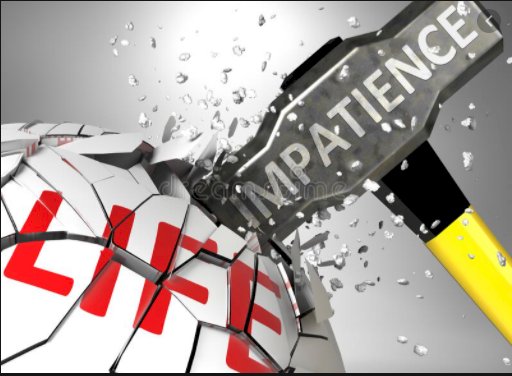IMPATIENCE is one of seven basic character flaws or “dark” personality traits. We all have the potential for impatient tendencies, but in people with a strong fear of missing out, Impatience can become a dominant pattern. Researchers discovered that women who were identified as impatient had shorter telomere length, which could be an initial predictor of disease and earlier mortality. Patience is indeed a virtue and women with impatient personality types are likely growing older at a faster pace than women disposed to be more patient. Noted Richard Ebstein from NUS.

What is impatience?
Impatience is usually defined as:
irritation with anything that causes delay; a restless desire for change and excitement; [1]
To be impatient is to feel and show hostility towards (or at least about) things which obstruct, frustrate or delay one’s goals. Impatient people resent being held up, whether intentionally by another person or just accidentally in the normal course of events.
Impatience has some similarity to the emotion of anger. Animals and people alike become enraged in response to deliberate outside threats to their well-being, or the well-being of their loved ones. The anger is partly an expression of the fear that comes from being threatened, invaded or mistreated, and partly a sort of warning shot, a firm “No!” to deter the outside threat from going any further.
Impatience is also somewhat different from anger, however, in that the impatient person is predisposed to perceive virtually all situations as threatening—not to their survival per se but to their goals. More exactly, it is as if their survival depends upon the accomplishment of as many goals as possible as quickly as possible.
Many people do not know how impatient thet were until it was pointed out to them. (This is true of chief features generally.) There are various giveaway signs, however: constant jaw-clenching and teeth-grinding, swearing at the slightest frustration, and a proneness to high blood pressure. Majority of people who are diagnosed with hypertension also had a chief feature of impatience.
The main characteristic of impatience include having a constant nagging fear of not being able to get enough done within a timeframe.
Components of impatience
Like all chief features, impatience involves the following components:
- Early negative experiences
- Misconceptions about the nature of self, life or others
- A constant fear and sense of insecurity
- A maladaptive strategy to protect the self
- A persona to hide all of the above in adulthood
Early Negative Experiences
In the case of impatience, the key early negative experiences revolve around being left out of activities. Perhaps the child was never allowed to participate in important events or decisions with the rest of the family. Perhaps the child was never allowed out of the house to have a normal social life like the rest of the kids. Either way, the child was left with a sense of missing out on life.
Misconceptions
From persistent experiences of missing out or being left out, the child comes to perceive himself as needing to make up for lost time:
The rest of the world is ahead of me. It’s so unfair. I have a lot of catching up to do.
Life is so short. Time is running out. I have wasted too much time already.
I have to get through every task as quickly as possible. I have no time for distractions, diversions, obstructions, failures.
Anything that slows me down is unacceptable.
Fear
Based on the above misconceptions and early negative experiences, the child becomes gripped by a specific kind of fear. In this case, the fear is of missing out—being unable to squeeze the maximum value out of every single second of life, being stuck in the present moment’s activity when the most important thing in life lies in the future, being unable to do all that needs doing before death strikes.
Strategy
The basic strategy for coping with this fear of missing out is to constantly resist spending time in the present and to virtually force one’s way into the future. Typically this involves:
- rushing through activities as quickly as possible, and rushing from one activity to the next;
- seeing others as either a help or a hindrance, and pushing hindering people out of the way;
- not tolerating slowness, delay or failure, either in others, in oneself or in life itself;
- being constantly prepared to go on the offensive, clenched and tensed up, ready to push ahead and punch a hole through any obstruction;
- reacting aggressively to any perceived hold-up.
The impatient child decides that he has to make the most of every remaining moment. Any opportunity to achieve his goals must be fully exploited. A single wasted moment is like another nail in his coffin.
Persona
Emerging into adulthood, the individual does not want go around being overtly afraid and insecure about running out of time before meeting death. Instead, he pretends—or rationalises—that his restlessness and hostility have nothing to do with him. It’s just that he has some very important work to do and other people keep getting in the way.
Hence the chief feature of impatience puts on a mask which says to the world, “It’s not me. It’s just that what I am doing right now is extremely important and urgent. And the thing I am doing next is even more important and urgent. So either help me out right now or **** off.”
All people are capable of this kind of behaviour. When it dominates the personality, however, one is said to have a chief feature of impatience.
Positive and Negative Poles
In the case of impatience, the positive pole is termed AUDACITY and the negative pole is termed INTOLERANCE.
Audacity is a willingness to take risks, to leap in where others fear to tread, ideally without causing any harm.
Intolerance, of course, is the absolute unwillingness to accept or endure any distraction, interference, obstruction or delay, no matter who or what the source. This can lead to angry outbursts and destructive behaviour.

Any source of delay or obstruction is unacceptable. Inanimate objects can be just as infuriating as as, say, incompetent road users or tardy school children. A car that won’t start first time is experienced as much an imminent threat as a burglar in the bedroom. Life itself can be regarded as a constant, unyielding obstacle.
Impatience is a key factor in what used to be known as the Type A personality. Typically these are highly competitive personalities (characteristic of young souls with a goal of dominance) as well as impatient. They are set up to be frustrated in their constant desire to achieve as much as possible now. It used to be believed that all highly driven people were prone to coronary heart disease. It is now thought that it is not the competitiveness or striving per se that foster heart disease but the level of hostility. This could be from a chief feature of impatience or a mode of aggression, or both.
Handling Impatience
As with every chief feature, the key is becoming conscious of how impatience operates in oneself. If you have impatience, you can begin by observing the persona in action:
- Do I exaggerate the importance and urgency of my activities?
- Do I see other people as either a help or a hindrance? Do I push and shove unhelpful others out of the way?
Try to catch yourself in the act of putting on your “I must quickly do something important” mask.
Then dig deeper:
- Why must I get everything done now?
- Why do I keep rushing to get to the next moment, the next activity?
- What am I afraid of?
- What do I fear would happen if I never got everything done and out of the way?
Approaching the deepest level you may need outside help in the form of a counsellor, therapist or at least a close friend:
- Where does this fear of missing out come from?
- How was I hurt?
- Can I let it go?
Insight in itself will not remove the impatience. By the time you reached adulthood, the neural pathways underlying your chief feature were pretty well established in the brain. Nevertheless, the brain is plastic, malleable, reconfigurable. Just as you can become more aware of impatience through self-observation and self-enquiry, so too you can gain more control over it through using that awareness and by exercising choice in the moment.
- Whenever I feel like punching life out of the way, I will now be more willing to accept the limitations of time.
- I will be more willing to let my goals slide. I will never get it all done before I die anyway.
Another way to handle a chief feature is to “slide” to the positive pole of its opposite. In the case of impatience, if you feel yourself getting caught in the grip of intolerance, the negative pole of impatience, you can re-balance yourself using the positive pole of martyrdom, namely selflessness. In other words, you focus attention on what someone else is seeking or trying to do, and you do something to help them even though there is no personal gain to be had. Spending time acting selflessly is a way to short-circuit the fear of missing out.
